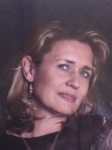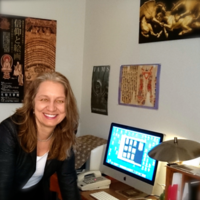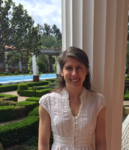Schedule, Speakers, and Abstracts
Schedule
1:00 PM Welcome (Eben Graves) and introduction (Blair Fowlkes Childs)
1:15-1:45 Lucinda Dirven, “The Dura Mithraeum. New Perspectives on an Old Find”
1:45-2:15 Zsuszanna Gulácsi, “Visual Catechism in mid-3rd century Mesopotamia”
2:15-2:45 Discussion and Q&A (moderated by Blair Fowlkes Childs)
2:45-3:00 Break
3:00-3:30 Alexis Belis, “Zeus Kasios: Iconography of a Greek Mountaintop Cult in Roman Syria”
3:30-4:00 Michael Blömer, “Where Iron is Born. The Sanctuary of Jupiter Dolichenus in Doliche”
4:00-4:30 Discussion and Q&A (moderated by Blair Fowlkes Childs)
4:30-5:00 Reception
Abstracts & Speaker Bios
 Lucinda Dirven, University of Amsterdam
Lucinda Dirven, University of Amsterdam
The Dura Mithraeum. New Perspectives on an Old Find
The Dura mithraeum, presently on display in the YUAG, represents one of the most complete assemblages of Mithraic material found in situ, including architecture, images (wall paintings, reliefs), some small finds and evidence for cult practice, and over two hundred graffiti and dipinti. A lot has happened since this mithraeum was first discovered in 1934; in the study of ancient religions in general and in the study of Mithras and Dura-Europos in particular. This paper will explore how these developments have changed the questions we may pose to this mithraeum that has played a key role in our perception of Mithras’ cult. Central to the talk will be new perspectives on personal ritual experience and how this influences our interpretation of the material remains. In this, special attention will be paid to the remains of other cults in Dura-Europos, such as the Christian baptistery.
Lucinda Dirven studied art history and theology (history of religions and comparative religion) at the University of Leiden, where she obtained her PhD that was published in 1999 as The Palmyrenes of Dura-Europos. A Case Study of Religious Interaction (Brill Publishers). After a post-doctorate at the archaeology department of the University of Amsterdam, she has been teaching at the history departments of the Universities of Utrecht and Amsterdam, to which she is now connected as a researcher. Ever since her PhD, her research has concentrated on the Roman and Parthian Near East (especially Dura, Hatra and Palmyra) on the one hand and the religious influences of these regions on the Roman West on the other hand. Her research sets out to combine material culture and written sources, mainly on religion. A recent topic has been religious continuity and change in Syria and Mesopotamia, especially during the Roman and Parthian periods. She recently curated an exhibition on Palmyra and its reception in the western world and studied iconoclastic movements, both in antiquity and nowadays. Currently, she is finishing a catalogue on the sculptures from Hatra and is preparing the final report on the mithraeum of Dura-Europos, together with Matthew McCarty (University of British Columbia).
 Zsuzsanna Gulácsi, Northern Arizona University
Zsuzsanna Gulácsi, Northern Arizona University
Visual Catechism in mid-3rd century Mesopotamia
Although much has been written about the religious art of Dura-Europos, the question of its Mesopotamian rootedness has gone largely unexplored from the perspective of Iranian Studies. This paper focuses on the pictorial program of the Dura synagogue as an example of Iranian Judaism. It explores the function of the northern Mesopotamian Jewish murals together with that of the contemporaneous pictorial art of the southern Mesopotamian Manichaeans. While the archeological records of the painted synagogue are silent, various characteristics of the mid-3rd-century Manichaean paintings are documented in literary records, including what they portrayed and the pedagogical reasons for how and why they were used. As evidenced by Parthian, Middle Persian, Coptic, and Syriac textual sources dating from between the mid 3rd and the late 4th centuries, the founding prophet of Manichaeism, Mani (active from 240 to 274 or 277 CE), wrote down his teachings and commissioned visual representations of them on a solely pictorial scroll, the Book of Pictures, used for oral instructions while missionizing across greater West Asia and the East Mediterranean region. When accessed together, the available evidence demonstrates that correlations between the religious function of Durene Jewish and Sasanian Manichaean art go beyond surface similarities: they both (1) displayed a visual library of doctrinal subjects that were also recorded in the sacred texts of their respective religions, (2) fulfilled a primarily educational role since their pictorial genres attest a dominantly instructional function, and (3) were sermonized about in light of living interpretations in an oral context. Through these points of similarities, I argue that during the middle of the 3rd century, the Durene Jews recognized the value of didactic images, as did their Manichaean neighbors—not as a result of direct influence, but rather as part of a regional, Iranian development of techniques of religious instruction.
Zsuzsanna Gulácsi is Professor of Art History at Northern Arizona University, Flagstaff, specializing in the contextualized study of pan-Asiatic religions. She is the author of Mani’s Pictures: The Didactic Images of the Manichaeans from Sasanian Mesopotamia to Uygur Central Asia and Tang-Ming China (Brill, 2015); Mediaeval Manichaean Book Art: A Codicological Study of Iranian and Turkic Illuminated Book Fragments from 8th – 11th cc. East Central Asia (Brill, 2005), Manichaean Art in Berlin Collections (Brepols, 2001); one edited volume: Language, Society, and Religion in the World of the Turks - Festschrift for Larry Clark at Seventy-Five (Brepols, 2018); as well as dozens of articles on Manichaean, Eastern Christian and Zoroastrian art. She is the editor of the Central Asia area of the Grove Encyclopedia of Asian Art and Oxford Art Online.
 Alexis Belis, The Metropolitan Museum of Art
Alexis Belis, The Metropolitan Museum of Art
Zeus Kasios: Iconography of a Greek Mountaintop Cult in Roman Syria
One of the most distinctive images on Roman coins of Seleucia Pieria, the port at the mouth of the Orontes River in Syria, is the image of a naiskos enclosing a conical cult object, usually identified as a sacred stone, with the legend Zeus Kasios. Zeus Kasios was the Greek deity worshipped on the summit of Mt. Kasion, a prominent mountain visible along the coast to the south. The image is unusual in that iconography associated with the cult of Zeus Kasios elsewhere in the ancient world represents the god in traditional anthropomorphic form. This feature was therefore specific to a local version of Zeus Kasios, and this paper argues that the combination of deity and iconography were inspired by long-standing indigenous religious traditions of mountain-gods and aniconic stone-cults. Archaeological remains and literary accounts attest to sacrifices made to the god on the mountaintop throughout the Roman period. However, the cult of Zeus Kasios was established by Greeks who settled in the area by the 8th century BC, and the mountain itself was considered sacred as early as the Bronze Age. Thus, the coins appear to recast worship of the Greek deity in a local aniconic religious tradition.
Alexis Belis is Assistant Curator at The Metropolitan Museum of Art and holds a PhD in Classical Archaeology from Princeton University. Her work focuses on Greek architecture, landscape, and religion, and in particular on cult activity on mountaintops. She has excavated at sites on Cyprus and in Greece, including the sanctuary of Zeus Lykaios on Mt. Lykaion in Arcadia. She is the author of Roman Mosaics in the J. Paul Getty Museum.
 Michael Blömer, Asia Minor Research Center, Münster University
Michael Blömer, Asia Minor Research Center, Münster University
Where Iron is Born. The Sanctuary of Jupiter Dolichenus in Doliche
A large number of monuments and inscriptions attest to the widespread veneration of the god Jupiter Optimus Maximus Dolichenus in many parts of the Roman Empire. In the second and third century CE, the cult gained popularity in the border provinces along the rivers Danube and Rhine and in Britain, but also in the city of Rome. The home of the cult, however, was Doliche, a small city in ancient north Syria. The main sanctuary is located on the summit of Dülük Baba Tepesi, a 1204 m high mountain that overlooks the city. Despite the prominence of the Jupiter Dolichenus cult in studies of Roman religion, the site has attracted surprisingly little attention. Systematic archaeological investigations started only in 2002. Since then, however, large parts of the sanctuary have been investigated and the rich results of the excavations have started to reshape our understanding of the cult. Most importantly, it was possible to ascertain that the sanctuary started to operate already in the early first millennium BCE and flourished in the period of Babylonian and Persian rule over Syria. Moreover, the evidence suggests that in the Roman period the sanctuary played a much bigger role for the worship of Jupiter Dolichenus in the Western provinces than has previously been acknowledged.
In my talk, I will outline the main results of the excavations in the Dülük Baba Tepesi sanctuary and their consequences for the understanding of the Jupiter Dolichenus cult in a local and global perspective.
Michael Blömer is an archaeologist whose research revolves around Asia Minor and the Near East in the Hellenistic and Roman period. He has worked on urbanism, sculpture, religious iconography, and the religious life of the Hellenistic and Roman Near East. Michal is also an experienced field archaeologist and co-director of the excavations at Doliche, South-East Turkey. He received his D.Phil. from Münster University in 2009. Since then he has worked as a research fellow at the Centre of Excellence “Religion and Politics” at Münster University and as Assistant Professor at the Centre for Urban Networks Evolutions at Aarhus University from 2015-2019. He is currently Assistant Professor at the Asia Minor Research Center at Münster University.